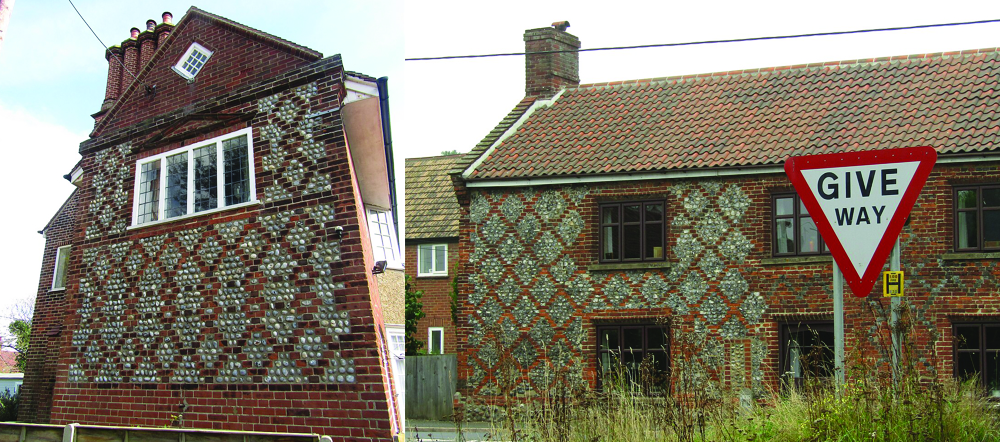Diapering in Construction
| Diaperwork or diapered flint by Kolforn under Creative Commons Attribution-Share Alike 4.0 International license |
Diapering in construction also called diaperwork refers the decorative treatment of a surface or facade with a repeating pattern of squares or chequers or rectangles. The terms stems from the latin 'dia' meaning across, describing the diagonal perpenicular lines creating diamond patterns.
It origins lie in Medieval times, often combining a flint stone wall with brick infill creating the repetitive pattern, an later with differing shades or materials of brick. It was a technique often used in Gothic and Tudor architecture often seen on churches, castles, and some houses to denote status and craftsmanship.
Diapering and the resulting geometric patterns can improve the visual interest of a facade, giving more depth and breaking the monotony of plain brick or flint surfaces surfaces and thus aesthetic value. It has also been used to create specific patterns or motifs that might represent the owner of the building such as guilds, religions, families or clans.
The technique to some extent can contribute to the structural integrity of a wall, with the interlocking patterns acting as structural ribs, distributing loads more evenly and potentially improving environmental resistance. Diapering might still be used today, often on brick facades likewise to add interest to plain brick surfaces. The employment of diapering today may be executed traditionally on site by a skilled brick layers or flinters (a flint worker) often on traditional buildings or off-site in the pre-production of modular building elements, brought to site and installed separately.
[edit] Related articles on Designing Buildings
- Airbrick.
- Aircrete blocks.
- Basic brickwork replacement.
- Blockwork.
- Bricklayer.
- Brick bats and closures.
- Brick burr.
- Brick sizes.
- Brick strip foundation.
- Brick veneer.
- Bungaroush.
- Cavity wall.
- Chalk aquifer.
- Clay.
- Clunch.
- Damp-proof course.
- Defects in brickwork.
- Dismantling of bricks for reuse.
- Efflorescence.
- Frog.
- Frost attack.
- Federation of Master Builders.
- How to lay bricks.
- Knapping.
- Limestone for building.
- Master mason.
- Masonry.
- Mortar.
- Pointing.
- Spalling.
- Specifying brick.
- Swift brick.
- The influence of geology on English brickmaking,
- Testing bricks.
- Treating brickwork with sealant or water repellent.
- Types of brick arches.
- Types of brick bonding.
- Types of bricks.
- Types of stone.
- Which way up should you lay a brick?
- Wall tie failure.
Featured articles and news
Gregor Harvie argues that AI is state-sanctioned theft of IP.
Many resources for visitors aswell as new features for members.
Using technology to empower communities
The Community data platform; capturing the DNA of a place and fostering participation, for better design.
Heat pump and wind turbine sound calculations for PDRs
MCS publish updated sound calculation standards for permitted development installations.
Homes England creates largest housing-led site in the North
Successful, 34 hectare land acquisition with the residential allocation now completed.
Scottish apprenticeship training proposals
General support although better accountability and transparency is sought.
The history of building regulations
A story of belated action in response to crisis.
Moisture, fire safety and emerging trends in living walls
How wet is your wall?
Current policy explained and newly published consultation by the UK and Welsh Governments.
British architecture 1919–39. Book review.
Conservation of listed prefabs in Moseley.
Energy industry calls for urgent reform.
Heritage staff wellbeing at work survey.
A five minute introduction.
50th Golden anniversary ECA Edmundson apprentice award
Showcasing the very best electrotechnical and engineering services for half a century.
Welsh government consults on HRBs and reg changes
Seeking feedback on a new regulatory regime and a broad range of issues.
CIOB Client Guide (2nd edition) March 2025
Free download covering statutory dutyholder roles under the Building Safety Act and much more.
























